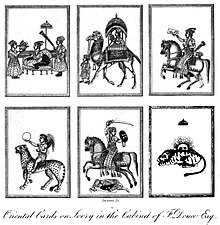Ganjifa
The game became popular at the Mughal court, and lavish sets were made, from materials such as precious stone-inlaid ivory or tortoise shell (darbar kalam).The game later spread to the general public, whereupon cheaper sets (bazâr kalam) would be made from materials such as wood, palm leaf, stiffened cloth or pasteboard.Different types exist, and the designs, number of suits, and physical size of the cards can vary considerably.These remain unproven theories, but the 18th century, traveler Carsten Niebuhr claimed to have seen Arabian merchants in Bombay playing with Chinese cards.[8] An exhibition in the British museum in 2013 noted "Playing cards are known in Egypt from the twelfth century AD.For example, the word 'kanjifah' ( كنجفة ) is written in the top right corner of the king of swords, on the Mamluk Egyptian deck witnessed by L.A. Mayer in the Topkapı Palace museum.[18] Shah Abbas II (r 1642-66) banned ganjifeh and the game decline precipitously with no known rules surviving into the present.In 1294, Gaykhatu began printing an imitation of Yuan banknotes in Iran although these were withdrawn quickly after merchants rejected them.[24] The earliest playing cards used in India were known as Patrakrida; they predated Ganjifa by several centuries, though no manuals exist today as to how they were used.[2] Rudolf von Leyden suggested that the Ganjifa cards may have been brought by the first Mughals from their ancestral homeland in Inner Asia.This took place in the month of Ramzan, on the night he left Agra to travel to nearby Fatehpur Sikri (Uttar Pradesh, India).By the 21st-century, the only place with a significant community of ganjifa makers and players is Odisha in the east of India, Mysore in Karnataka, Nirmal in Telangana, Sawantwadi in Maharashtra, Rajasthan, Kashmir, Bishnupur in West Bengal and Sheopur in Madhya Pradesh.Variations can be played where 21 is a target total (but only if made with a King and a 9, or a Vizier and a ten), or where different winning combinations are accepted such as pairs, triples and so on.










Dashavataracard gameplaying cardsGanjapaÉmile Prisse d'AvennesartisansMughalpalm leafpip cardscourt cardsPersiaHoutum-SchindlerStewart CulinWilliam ChattoCarsten NiebuhrJean Louis BurckhardtFrench deckL.A. MayerTopkapı PalaceEdmund de UngerOne Thousand and One NightsIbn TaghribirdiWilliam Henry WilkinsonSpanishItalian playing cardsMadiaoKhanhooStrings of CoinsmyriadRichard EttinghausenIbn Hajar al-HaytamiFrancis DouceSamuel Weller SingerAhli ShiraziAustrian National LibrarySafavidAbbas IIAs-NasAlbert Houtum-SchindlerâsanâsMichael Dummetttrick-taking gameGaykhatuYuan banknotesBâburBaburnamaEdward TerrylithographyOffset printingEuchreBridgeBeloteBalootCary Collection of Playing CardsDe La RuePersianOdishaDashavatara GanjifaSawantwadiMaharashtraBishnupurWest Bengalten avatarsVishnuMatsyaKuchhaVarahaNarsinghaVamanaParashuramaBalaramKrishnaJagannathBuddhaKalankiRamayanRavanazodiacgamblingKrishnaraja Wadiyar IIItrumpswild cardspalanquinSritattvanidhiAin-i-AkbariLeo Aryeh MayerNabagunjaraArjunafollow the suitBlackjackGerman Playing Card MuseumBeinecke LibraryIndira Gandhi National Centre for the ArtsVictoria and Albert MuseumBritish MuseumLos Angeles County Museum of ArtBodleian LibraryPowis CastleRobert CliveNational Museum of New DelhiAllahabad MuseumJaganmohan PalaceSrirangapattanaDr. Bhau Daji Lad MuseumPitt Rivers MuseumManjusha MuseumCambridge University LibraryWayback MachineCourt pieceChinese playing cardsSpanish playing cardsMaisirSawantvadiHumayunThe Playing-CardKatip ÇelebiJean-Baptiste TavernierJean ChardinAshtor, EliyahuInternational Playing-Card SocietyAsia SocietyConstantinoplearchive.todayAbu'l-Fazl ibn Mubarakmost gamesMinchiate